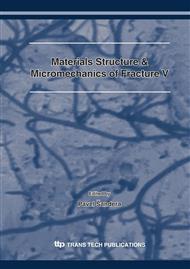[1]
T.C. Lowe: JOM, Vol. 58 (2006), p.28.
Google Scholar
[2]
M.A. Meyers, A. Mishra and D.J. Benson: Progress Mat. Sci., Vol. 51 (2006), p.427.
Google Scholar
[3]
H.W. Höppel, M. Kautz, C. Xu, M. Murashkin, T.G. Langdon, R.Z. Valiev and H. Mughrabi: Int. J. Fatigue, Vol. 28 (2005), p.1001.
Google Scholar
[4]
A. Vinogradov: Mater. Sci. Forum, Vol. 503-504 (2006), p.267.
Google Scholar
[5]
A. Vinogradov and S. Hashimoto: Advanced Engng. Mater., Vol. 5 (2003), p.351.
Google Scholar
[6]
H. Mughrabi, H.W. Höppel and M. Kautz, in: Ultrafine Grained Materials IV, edited by Y.T. Zhu et al., The Minerals, Metals & Materials Society, (2006), p.1.
Google Scholar
[7]
P. Lukáš, L. Kunz and M. Svoboda: Mater. Sci. Eng. A, Vol. 391 (2005), p.337.
Google Scholar
[8]
L. Kunz, P. Lukáš and M. Svoboda: Mater. Sci. Eng. A, Vol. 424 (2006), p.97.
Google Scholar
[9]
P. Lukáš, L. Kunz and M. Svoboda: Met. Mat. Trans. A (2007), in print.
Google Scholar
[10]
M.C. Murphy: Fatigue Engng. Mater. Struct., Vol. 4 (1981), p.199.
Google Scholar
[11]
P. Lukáš and L. Kunz: Mater. Sci. Eng. A, Vol. 103 (1988), p.233.
Google Scholar
[12]
J. Awatani, K. Katagiri, A. Omura and T. Shiraishi: Met. Trans. A, Vol. 6 (1975), p.1029.
Google Scholar
[13]
H. Mughrabi, H.W. Höppel and M. Kautz: Scripta Mater., Vol. 51 (2004), p.807.
Google Scholar
[14]
S.R. Agnew, A.Y. Vinogradov, S. Hashimoto and J.R. Weertman: J. Electronic Mater., Vol. 28 (1999), p.1038.
Google Scholar
[15]
A. Vinogradov and S. Hashimoto: Mater. Trans., Vol. 42 (2001), p.74.
Google Scholar
[16]
H. Mughrabi and H.W. Höppel, in: Structure and Mechanical Properties of Nanophase Materials - Theory and Computer Simulation vs. Experiment, edited by D. Farkas et al., Materials Research Society, (2000), p. B2. 1. 1.
Google Scholar
[17]
S.R. Agnew and J.R. Weertman: Mat. Sci. Eng. A, Vol. 244 (1998), p.145.
Google Scholar
[18]
W.D. Pilkey: Peterson's Stress Concentration Factors (Wiley Interscience Publication, New York, 1997).
Google Scholar
[19]
P. Lukáš, L. Kunz, B. Weiss and R. Stickler: Fatigue Fract. Eng. Mater. Struct., Vol. 9 (1986), p.195.
Google Scholar
[20]
A. Seeger, in: Handbuch der Physik VII/2, edited by S. Flügge, Springer-Verlag, Berlin, (1958), p.115.
Google Scholar
[21]
Z.S. Basinski, A.S. Korbel and S.J. Basinski: Acta Metall., Vol. 28 (1980), p.191.
Google Scholar
[22]
C. Holste: Phil. Mag., Vol. 84 (2004), p.299.
Google Scholar
[23]
C.E. Feltner and C. Laird: Acta Metall., Vol. 15 (1967).
Google Scholar


